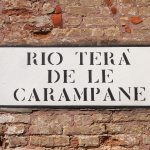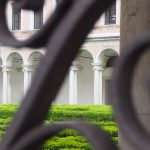In 2020 and 2021 a new, terrible virus and the subsequent resulting COVID pandemic turned the world upside down. We all were suddenly confronted with words such as to be in lockdown, FFP2 masks, social distancing. These words continue very sadly to ‘persecute’ and follow us until today.
But now a new word, vaccine, and the resulting vaccine campaign, should give us hope.
A well-known mask of Venice comes up to one’s mind, the famous mask of the Doctor of Plague (you may recall Prof. Robert Langton’s vision while lying in hospital in Florence in Dan Brown’s novel Inferno and in Ron Howard’s homonymous movie).
Doctors in Venice would wear a mask with a long beak stuffed with a sponge of herbs and mixed spices, glasses would protect their eyes or glass was applied directly onto the openings of the mask, while the doctors used their stick to maintain social distancing and to lift the robes of their patients.
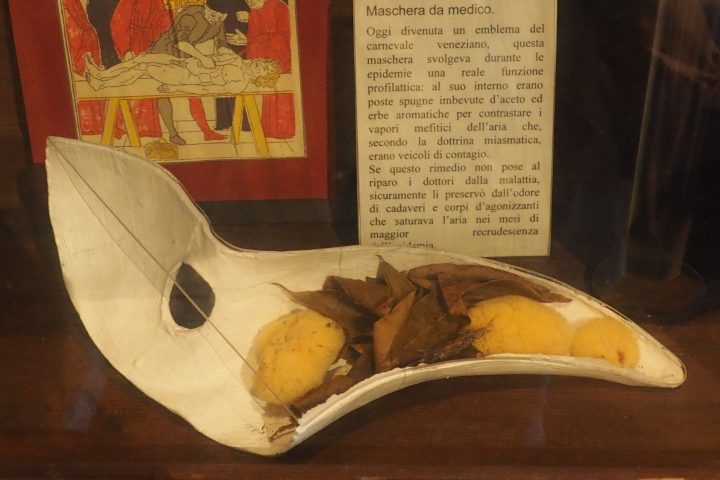
mask worn by the Doctor of Plague
In the Middle Ages Venetian doctors had to face leprosy, malaria, cholera, but mostly plague waves, named only in the 18th century the Black Death.
Plague was an extremely contagious infectious bubonic, pneumonic or septic deadly disease that first struck Europe during the reign of the Emperor Justinian. Doctors in Venice were confronted with severe outbreaks in 1348, in 1575 and finally in 1630, all with extremely high mortality rates.
The first plague of 1348 for example caused 30 million dead, 37,000 to 70,000 Venetians estimated out of the 110,000 inhabitants at that time died. Around 30% of the 100 million inhabitants of Europe perished.
Besides (Ffp2) masks, (social distancing) sticks, how was (lockdown) isolation ‘organized’ in the past centuries? How did doctors deal in Venice with these devastating epidemics?
Doctors in Venice were divided into two categories ‘doctor’ and ‘apothecary’ (speziale), both regulated already back in 1258. The first category was divided into two further categories ‘surgeon’ (chirurgo) and ‘physician’ (medico fisico). To the second belonged ‘apothecary’ and ‘apotecario da grosso’ like ‘grocer’ (droghere) and ‘pharmacist’ (farmacista).
THE DEADLY BREATH
Plague derives from the Indo-European *pes, deadly breath.
Morbidity (rate between sick and non-sick), case fatality rate (between dead and sick) and mortality were extremely high, the incubation 2 to 5 days, the course of the disease 2 to 5 days only.
Plague is caused by the bacterium Yersinia Pestis that was discovered only in 1894. Cause was the flea Xenopsylla cheopis; its bites would infect rats and these black rats travelled indolently and happily on Venetian ships through the Mediterranean from harbour to harbour, thus spreading quickly the disease everywhere. The Venetian economy depended on trade, so no one was willing to limit the transit of ships. However, a different solution had to be found, because the plague meant the end of the economy anyway and for the sake of the motto salus populi suprema lex esto, the health of the people had to be the supreme law.
The first public health resolution was the creation of three Sapientas Savi for health in 1348 (who could at that point only attend to practical matters such as how to get rid of all corpses in Venice) and in 1485 three Provveditori alla Sanità, chosen by the Senate for 12 months, unpaid (to which two were added in 1556). Their seat was in the Fondaco delle Farine close to San Marco so that the ‘novellisti’ could check from the bell tower which ships were approaching Venice.
CREATION OF THE FIRST LAZARET – LAZZARETTO VECCHIO
The first countermeasure to possible outbreaks was opening on 28th August 1423 a permanent, secular hospital for all the sick struck by plague on a 2,5 hectares small island in the southern lagoon Lazzaretto Vecchio using public money from the rich Magistrato al Sal. The Doge Francesco Foscari was ruling; four of his sons died of the plague.
It was a revolutionary decision: before this year the care of the sick was relegated to religious orders and their charity and this hospital was to be a permanent one.
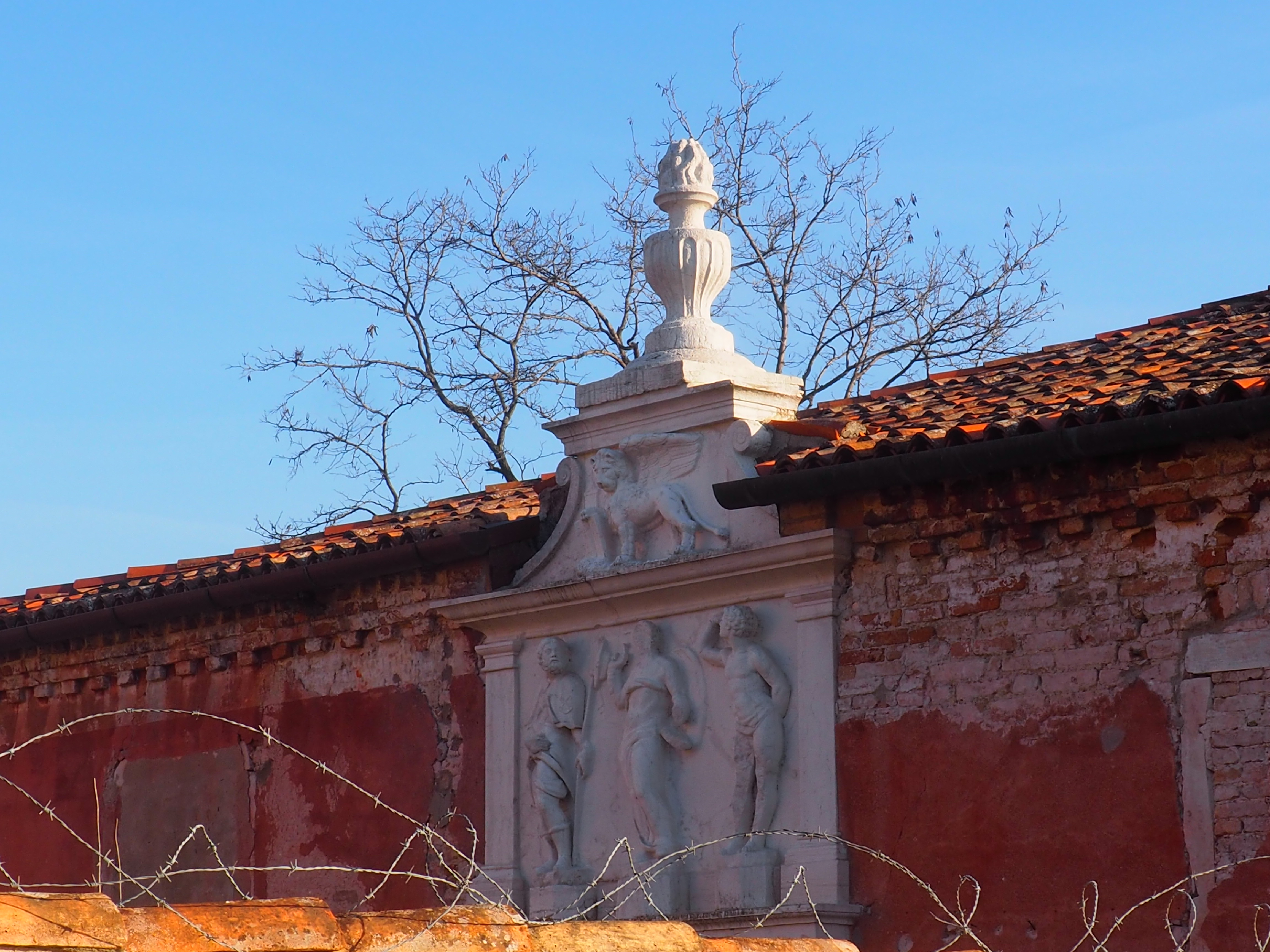
entrance to the island Lazzaretto Vecchio
This accommodation was planned not only for contaminated sailors or ships but also infected Venetians.
The government realized soon this first island was not sufficient where to gather the sick, it was necessary also to track possible plague-struck visitors or Venetians and organize their isolation too.
PREVENTION OF THE INFECTION – LAZZARETTO NUOVO
In 1468 a 20 hectares big island Lazzaretto Nuovo in the northern part of the lagoon, just 3 km away from Venice, was set up for the prevention of the spreading of a plague, again by using public state money.
Lazzaretto Nuovo became the quarantine island to control suspicious cases on board for sailors, crew, their goods and all those survivors from the Lazzaretto Vecchio in need of physical recovery.
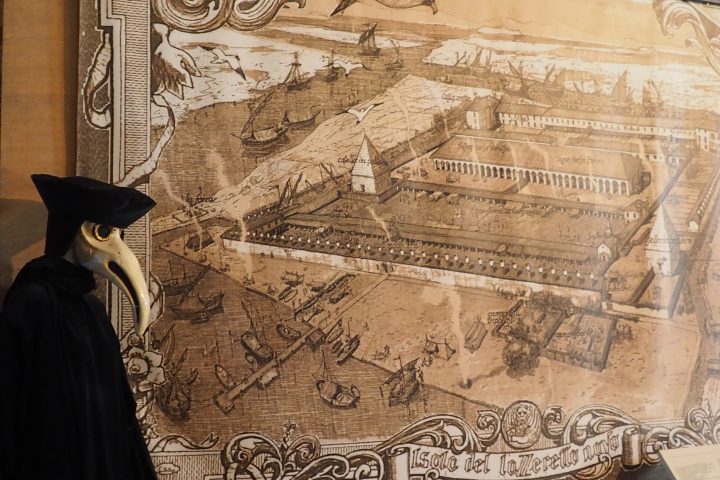
Doctor of Plague and Lazzaretto Nuovo
In old documents this island is defined as ‚cum mura circondata‘ (surrounded by walls) and ‚vigna murada‘ (walled vineyards). The island is still nowadays surrounded by a 1 km long brick wall with 1000 gun-slits that was rebuilt during the Austrian occupation between 1830 and 1840.
Through a door we step into a big field with a long line of mulberry trees.
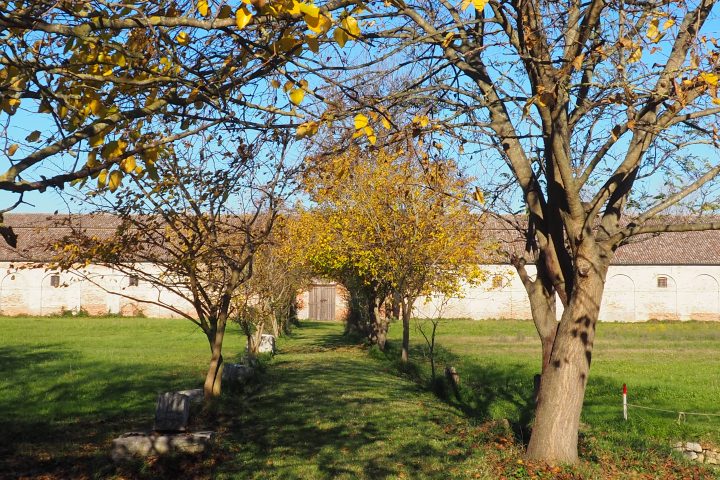
mulberry trees in November 2020
TEZON GRANDE
Nowadays a big warehouse TEZON GRANDE for the goods survives together with traces of the small TESE for the sick.
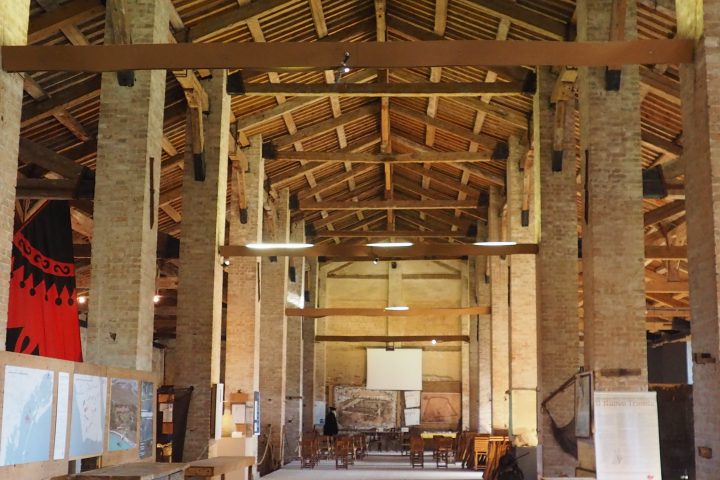
the inside of the Tezon Grande
Impressive is the size of Tezon Grande (22 x 10 metres), 102 metres long, the second longest building of Venice after the rope-yard (corderie) of the Arsenal.
Here according to protocols the goods were stored by porters and cleaned by smoking with rosemary, aromatic herbs and juniper. The arches were once open (the Austrians walled them in, raised the building about 1 metre and supported the big roof by adding 9 pilasters). So imagine 30 arches on each side, plus 2, in order for the goods to be aired. From above armed guards checked all processes.
Coins were cleaned with water and vinegar. Sounds very familiar doesn’t it?
Mysterious letters, numbers and signs referring to these former goods appear on the walls and several descriptions like this one of a ship from Cyprus.
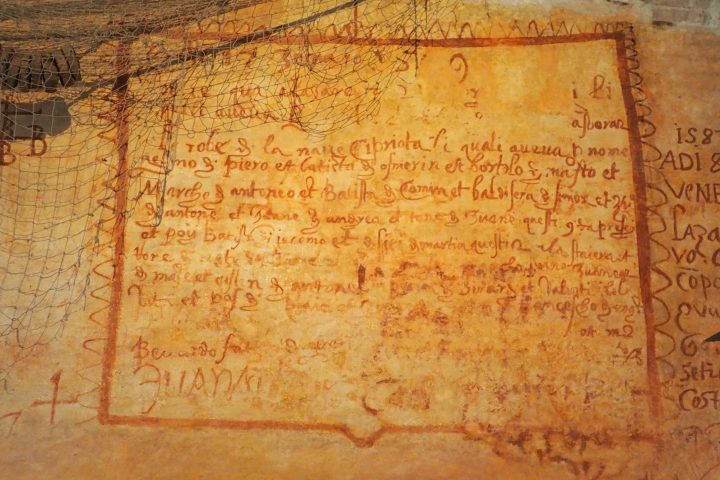
4,1 x 2,2 metres big inscription on which 1569 and a ship from Cyprus ‚nave cipriota‘ are mentioned
It is a real miracle that these inscriptions have survived despite humidity, later-added layers of mortar and what a nice and easy-to-read writing!
The present Tezon is divided into two portions, Venice side and Burano side, where nowadays the archeological pieces that resurfaced from here or close nearby in the lagoon are now kept.
On the opposite wall another nice inscription in the best preserved handwriting naming the Doge Cicogna.
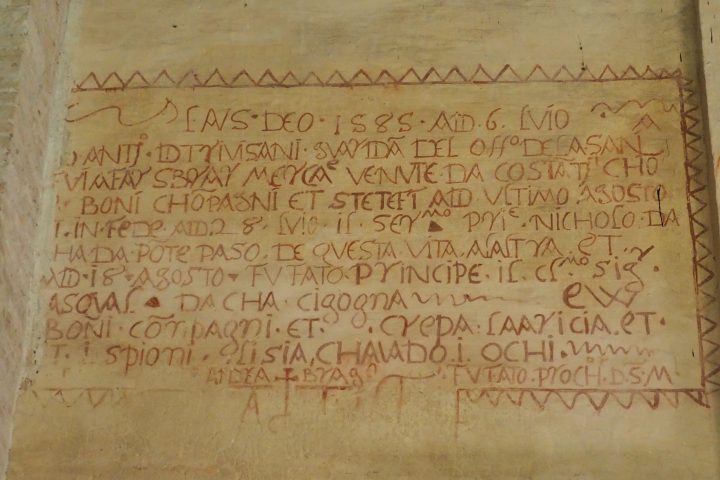
2,5 x 1,45 metres big inscription framed by a triangular ‘wolf tooth’ pattern ‚denti da lupo‘ from 1585 mentioning the Doge Cicogna in nice calligraphy
Let us now return to the fresh air.
PALACE OF THE PRIOR
On our visit of the Lazzaretto Nuovo we will learn more about this man, the Prior, who was elected for 4 years. His house was in the northern part of the island, disposed of a small courtyard with a well. There were 7 to 8 wells on the whole island.
The view of the swampy lagoon is breathtaking from there.

small canals and salt flats around the quarantine island Lazzaretto Nuovo
The Venetian Francesco Sansovino described the island as a castle with 100 rooms; the wall and the 100 chimneys are clearly recognizable in old etchings.
Thousands of people were isolated here, 3,000 or 4,000 in the peak of an infection; when bed capacity was down to zero, then 3,000 ships, floating lazarets, were then used for additional 8,000 to 10,000 sick.
While wandering through the island we will spot the surviving parts of these houses. The food was handed over by long wooden sticks with bread, meat and hard biscuits.
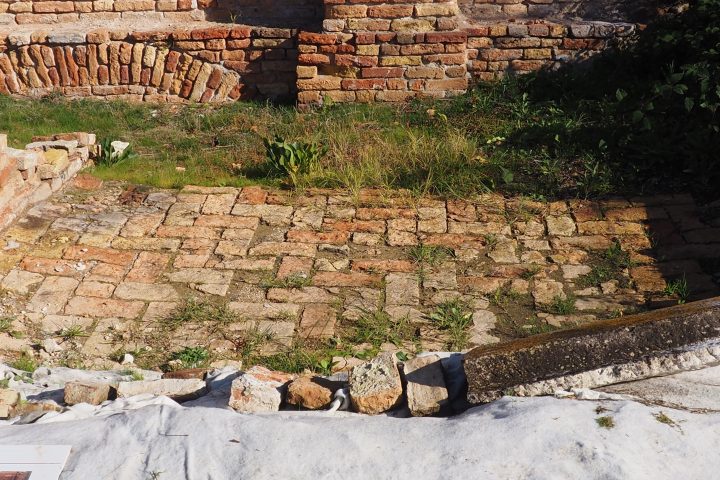
traces of the outline of the ground floor of these buildings
We will pass by the remains of Saint Bartholomew’s Church. Close nearby was located the cemetery for Christians and Muslims that became later on an embankment. So far 5 levels have been dug up and coins from all over the world unearthed.
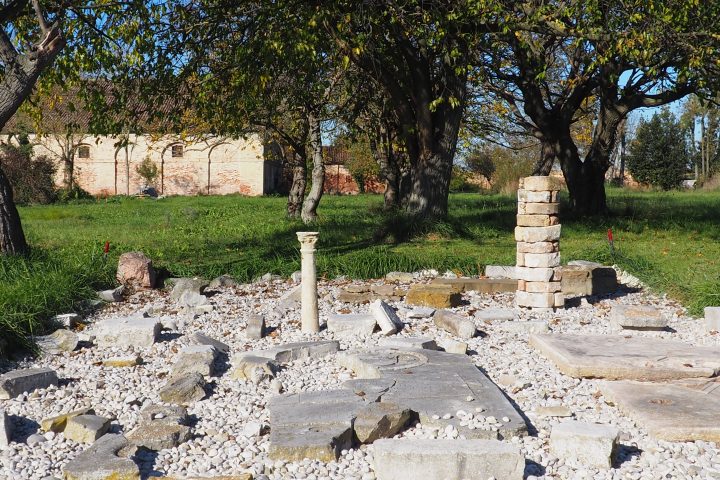
still visible outine of the Church of Saint Bartholomew
GUNPOWDER MAGAZINE
A gunpowder magazine stands out. In the 16th century gun powder was much requested. It is a mixture of saltpetre, carbon and sulphur. Saltpetre, potassium nitrate, was produced in the lagoon and kept until the explosion in the Arsenal in 1569 there. To prevent further explosions 20 gunpowder magazines Caselli da Polvere were built in the lagoon, only 4 survive and 2 here on Lazzaretto Nuovo.
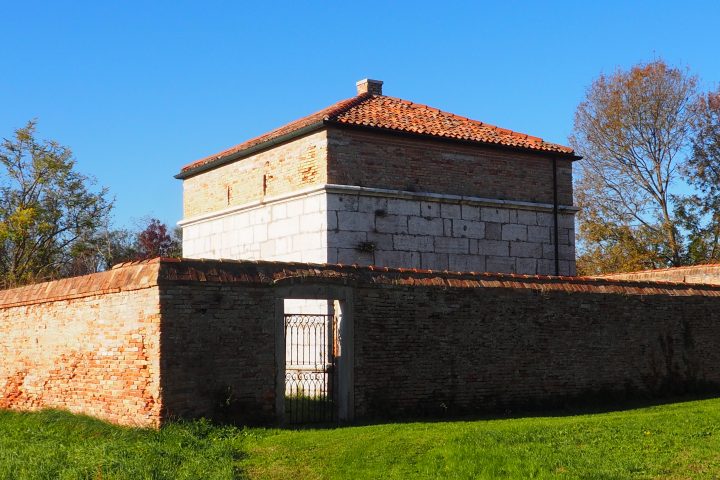
gunpowder magazine made using standard blocks in the eastern part of Lazzaretto Nuovo
The island is nowadays uninhabited, it was used up to the 18th century; fortified by the French and the Austrians and was connected to the close nearby lying island of Sant‘ Erasmo (traces of tracks are still clearly recognizable), it was closed by the Ministry of Defence in 1975. Given to an association of volunteers Ekos Club, passed on 1988 to Archeo Club that in the 90ties started excavations and restoration works.
SAN LAZZARO – LEPROSY
To complete the picture we should mention another disease, leprosy (from the Greek to peel off) is a contagious chronic disease, the incubation time is long, approx. 5 years, the course of the disease, 1 to 20 years, the mortality rate not very high.
In the 13th century the rise of Serenissima started. Decor had to reign everywhere on the streets, also deformed beggars with scaly skin lesions and flat noses had to be hidden away from society. A hospital run by religious monks was opened in 1262 on 3,5 hectares small island of San Lazzaro in the southern part of the lagoon.
Does this island still exist? We will go into details of all these matters during our visit and more. What were Fide Sanità and Patenti di Sanità? Which saints were venerated against plagues? Why was Francesco Diedo so important in spreading the veneration of Saint Roch? What was the drink Teriaca made of?
Fiona Giusto
www.venicetours.it



